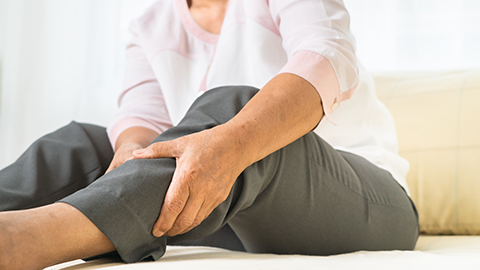
A client has orthostatic tremor, also called shaky leg syndrome. But this condition can shake up a lot more than legs! Here is a situation with no information about the best role for massage. Is there anything we can do for this client?
Resources: 
Pocket Pathology: /abmp-pocket-pathology-app
Benito-León, J. and Domingo-Santos, Á. (2016) ‘Orthostatic Tremor: An Update on a Rare Entity’, Tremor and Other Hyperkinetic Movements, 6, p. 411. doi:10.7916/D81N81BT.
Casciaro, Y. (2016) ‘Massage Therapy Treatment and Outcomes for a Patient with Parkinson’s Disease: a Case Report’, International Journal of Therapeutic Massage & Bodywork, 9(1), pp. 11–18.
Orthostatic Tremor Significantly Affects Quality of Life (2010) Mayo Clinic News Network. Available at: https://newsnetwork.mayoclinic.org/discussion/orthostatic-tremor-significantly-affects-quality-of-life/ (Accessed: 3 May 2022).
‘Primary Orthostatic Tremor’ (no date) NORD (National Organization for Rare Disorders). Available at: https://rarediseases.org/rare-diseases/primary-orthostatic-tremor/ (Accessed: 2 May 2022).
Riou, N. (2013) ‘Massage therapy for essential tremor: quieting the mind’, Journal of Bodywork and Movement Therapies, 17(4), pp. 488–494. doi:10.1016/j.jbmt.2013.03.007.
Vidailhet, M. et al. (2017) ‘Lessons I have learned from my patients: everyday life with primary orthostatic tremor’, Journal of Clinical Movement Disorders, 4(1), p. 1. doi:10.1186/s40734-016-0048-5.


Anatomy Trains is a global leader in online anatomy educationand alsoprovides in-classroom certification programs forstructuralintegration in the US, Canada, Australia,Europe, Japan, and China, as well as fresh-tissue cadaverdissectionlabs and weekend courses. The work of Anatomy Trains originated with founder Tom Myers, who mapped the human body into 13 myofascial meridians in his original book, currently in itsfourthedition and translated into 12 languages. The principles of Anatomy Trains are used by osteopaths, physical therapists, bodyworkers, massage therapists, personal trainers, yoga, Pilates,Gyrotonics, and other body-minded manual therapists and movement professionals. Anatomy Trains inspires these practitioners to work with holisticanatomy in treating system-wide patterns to provide improved client outcomes in terms of structure and function.
Website:anatomytrains.com
Email:info@anatomytrains.com
Facebook:facebook.com/AnatomyTrains
Instagram: www.instagram.com/anatomytrainsofficial
YouTube:https://www.youtube.com/channel/UC2g6TOEFrX4b-CigknssKHA
0:00:01.2 Ruth Werner: Hey, I Have a Client Who listeners, did you know I have a growing library of NCB-approved, one hour online self-paced continuing education courses that you can do any time, anywhere? Well, now you know. Current classes include, What's Next: COVID-19 Updates for Massage Therapists, and A Massage Therapist's Introduction to Pharmacology Part One, and brand new, A Massage Therapist's Introduction to Pharmacology Part Two. Classes are $20 each and they confer one hour of continuing education credit. Wanna know more? Visit my website at ruthwerner.com and check it out. Be sure to sign up for my mailing list so you'll never miss a new class.
0:00:47.6 Speaker 2: Anatomy Trains is delighted to invite you to our in-person fascial dissection workshop, May 30th through June 3rd, 2022. We're excited to be back in the lab with Anatomy Trains, author Tom Myers and master dissector, Todd Garcia in Todd's Laboratory of Anatomical Enlightenment in Boulder, Colorado. Join students from around the world and from all types of manual, movement and fitness professions to explore the real human form, not the images you get from books. Visit anatomytrains.com for details.
[music]
0:01:33.5 RW: Hi, and welcome to I Have a Client Who, Pathology Conversations with Ruth Werner, the podcast where I will discuss your real life stories about clients with conditions that are perplexing or confusing. I'm Ruth Werner, author of A Massage Therapist Guide to Pathology, and I have spent decades studying, writing about and teaching about where massage therapy intersects with diseases and conditions that might limit our client's health. We almost always have something good to offer, even with our most challenged clients, but we need to figure out a way to do that safely, effectively and within our scope of practice. And sometimes as we have all learned, that is harder than it looks. Today's, I Have a Client Who, story comes from a colleague who reached out to me via my Facebook page. You can do that too, by the way. I'm at Ruth Werner's Pathology Page. And this person asked this very interesting question.
0:02:33.9 RW: They said, "I have a client who has orthostatic tremors. My quick research doesn't provide much. PubMed House one study that indicates massage had positive effect reducing resting and standing tremors in a patient with long-standing Parkinson's disease. Do you know anything about orthostatic tremors, or might you know enough about it to know if chiropractic focus on her atlas might be beneficial? The latter is just me taking a stab at a helpful modality for her. PS, it is neurological." Well, the first thing I did was refer this contributor to the section in my pathology book on tremors, which can at least give us some common vocabulary to talk about the situation. But I found that what I wrote in that piece doesn't really address some of the special features of orthostatic tremors. So for this episode, I needed to do some more digging.
0:03:28.7 RW: And I found the ground was hard and rocky and repelled my shovel, which is sort of a poetic way of saying, we don't know very much about the situation and the options for treatment are often not satisfactory, and we have exactly zero about massage therapy for clients who live with orthostatic tremors. While it is extremely frustrating to live with this, maybe rare and definitely poorly understood condition, it does provide some possibilities for our work as we will see. To talk about orthostatic tremor though, first we have to understand what tremors are, and to do this, I'm gonna go back and take a paragraph directly from my book. The term tremor refers to involuntary oscillating movements on a fixed plane. This can be a free-standing disorder or a symptom of a number of different types of central nervous system problems. The key characteristics of tremor disorders are that the movements are rhythmic back and forth, movements of antagonistic muscle groups, and the movement occurs in a single plane.
0:04:35.7 RW: And this distinguishes tremor from dystonia, which may involve involuntary movement in multiple planes. Tremors vary by velocity, amplitude, and the body parts involved. Now, from my reading about orthostatic tremor, this is still an accurate description, but the plane of movement may be hard to discern because the velocity of these tremors is usually very high, and the amplitude, that is the range of motion that the body part moves through tends to be quite small. In fact, sometimes, orthostatic tremor is so fast and so small that it is difficult to detect without special tests. Tremors are sometimes discussed as physiologic issues or pathologic issues. Physiologic tremors are exacerbated by stress, or fear, or hyperthyroidism or certain other kinds of problems. In fact, orthostatic tremor may look a lot like fear-related trembling, but it is confined to the legs.
0:05:37.8 RW: Pathologic tremors are often idiopathic, which at this point is definitely the case with our situation today. This condition of orthostatic tremor is a relatively new diagnosis. It was first proposed in 1984 by a doctor named Heilman, but we have a medical record from 1970 of some cases that probably fit this description. It turns out that this is a fairly controversial topic among neurologist, with some people claiming that this is a sub-type of essential tremor... That's a very common situation... And others who support that this is an entirely different entity. We think orthostatic tremor occurs more often in females than in males. And while it has been observed in children and young adults, it appears to be most common in mature people. And the primary symptom is uncontrolled tremor in the legs while standing. It is sometimes called shaky leg syndrome.
0:06:38.2 RW: People report a significant fear of falling and un-steadiness. And among the few studies of this condition, about a quarter of all patients described having had at least one fall related to orthostatic tremor. Some people with orthostatic tremor also develop some level of tremor in the arms, but that is not consistent. And this condition appears to be progressive leading to increasingly severe symptoms over time. Patients often adopt a wide stance with their feet for better balance, and they may dig their toes into the floor or into their shoes to try to avoid falling. One signature sign of orthostatic tremor is the speed of the tremor. This seems to separate it from essential tremor and Parkinson's disease, because the tremors with these conditions are much slower. This has also given rise to another observation that is sometimes called the hem sign.
0:07:30.7 RW: The hem of a skirt or a long shirt that covers the thighs of a person with OT will shake and tremble because of the leg tremors. The tremors may occur after several minutes of standing, but for some patients, they develop immediately on standing up. Walking or leaning on tables or counters can help, but it doesn't solve the problem. So orthostatic tremor is a situation where the legs and the legs only develop a fast, often subtle tremor during standing. It does not occur while sitting, reclining or walking. But any activity that requires standing may trigger this neurological response that feels like the person's legs may not support them. Think of all the ways we stand still for varying amounts of time every day. And if it is prohibitively difficult, well, what that might include things like washing dishes or standing in line for things, or maybe riding a bus or a train, or chatting with friends. What do you do that involves several minutes of standing still each day?
0:08:34.2 RW: I found a lovely article, which of course, I will share in our show notes, in which a doctor described a patient with orthostatic tremor. And I thought it was a truly eloquent portrait of what this condition can do. Here's a quote, "A 46-year-old lady was diagnosed with primary orthostatic tremor POT, based on the cardinal symptoms. Feelings of instability, leg tremor and fear of falling in the standing position. Improvement with walking and disappearance while sitting. Frequency of tremor is in the 13 to 18 hertz range in a normal neurological examination." She gives illustrative examples of her disability in everyday life. Shower, public transportation, shopping. She reports how she felt stigmatized by her invisible disorder. As a consequence, she developed anxiety, depression, and social phobia. All these struggles are unknown or under-recognized by her doctors and her family.
0:09:34.4 RW: Over time, three general practitioners examined her and the proposed diagnoses were depression, chronic fatigue syndrome, and functional disorders for which she was prescribed antidepressant therapy without any beneficial effect. The patient adds, "I feel stigmatized by an invisible disease and I've progressively lost my self-esteem. I had the impression of being misunderstood and that people were not taking my trouble seriously. The diagnosis was a relief. At last I could explain my troubles in simple words. Eventually, I've joined the patients association in order to increase the awareness of people and doctors." The treatment options for orthostatic tremor are extremely limited. Every resource I looked at basically offered Klonopin or Neurontin, and both of these drugs interfere with neurological function and can have side effects that include intolerable fatigue and brain fog. Also, they don't seem to work well for a lot of patients, which brings them back to square one for treatment options.
0:10:37.1 RW: It seems clear to me that this is a really challenging situation to live with, that obviously has an impact on every part of a person's quality of life. Their strength and physical stability for sure, but also their mood and emotional state... Their relationships and support systems... Everything might feel a bit shaky. But for us, the key question is, can massage help? We have absolutely no data, one way or the other, specifically about massage and orthostatic tremor. We do have some hints about tremors. The study, our contributor cited is a Parkinson's disease study, and it's a case report. We have another case report about massage and essential tremor. And of course, I'll put both of these in the show notes, and I'm happy to point out that these papers are the result of the massage therapy foundations case report contest, and they may provide readers with some ideas about how massage therapy can be helpful for clients with tremor in general.
0:11:37.1 RW: But when we think about this client, where does it leave us? Our contributor asks about chiropractic, which is outside my scope of knowledge. I did do a little Googling on orthostatic tremor and chiropractic and found nothing, but I frankly didn't spend a lot of time on this. I would also be interested to see if acupuncture, which is often useful for neurological issues might be helpful. But what about massage? I think this client's legs must be exhausted. I bet all of her leg and postural muscles are really worn out with trying to prevent falls and trying to help her to be stable and steady. Orthostatic tremor doesn't alter sensation, which means she's probably not numb. And frankly, I can't think of any other risks for body work.
0:12:26.9 RW: Of course, I would recommend starting slowly and working incrementally to see how our work is tolerated, and that will allow us to alter strategies as we go, but I can imagine that receiving massage to those tired feet and leg and back muscles might feel like heaven. So I would love to encourage our contributor to go ahead and see if their work might be helpful. I think a letter to the client's neurologist outlining their basic treatment plan and goals is a great idea, just in case there's anything we haven't thought of in terms of reasons massage therapy might not be in the client's best interest, but it seems to me like this is a great opportunity to offer something that could be really helpful and supportive to a person who needs it.
0:13:10.4 RW: Is massage therapy likely to cure orthostatic tremor? Definitely not. But if we're helpful, we should know this. And you know how I'm gonna conclude, right? I want to urge this massage therapist to take careful notes and to consider writing a case report on the situation so that other massage therapists can benefit from this experience and wisdom. Hey everybody, thanks for listening to, I Have a Client Who, Pathology Conversations with Ruth Werner. Remember, you can send me your, I have a client who stories to ihaveaclientwho@abmp.com. That's ihaveaclientwho All one word, all lowercase @abmp.com. I can't wait to see what you send me and I'll see you next time.